Do you want to create a new recipe?
We all have moments of running out of ideas on what to cook. Although most of us would prefer preparing dishes that we are familiar with, we often repeatedly serving the same dishes at home.
After cooking for more than a decade in the restaurant and being in charge of recipe development, I have a few practical ideas to change the game of new recipe creation.
These are simple ideas that you can use immediately. No specialty ingredients are required, no complicated techniques are involved, and you can do it in your kitchen right now.
Here is a list of my tips, followed by a new recipe that I created recently using some of these methods.
Let’s get into the details right now.
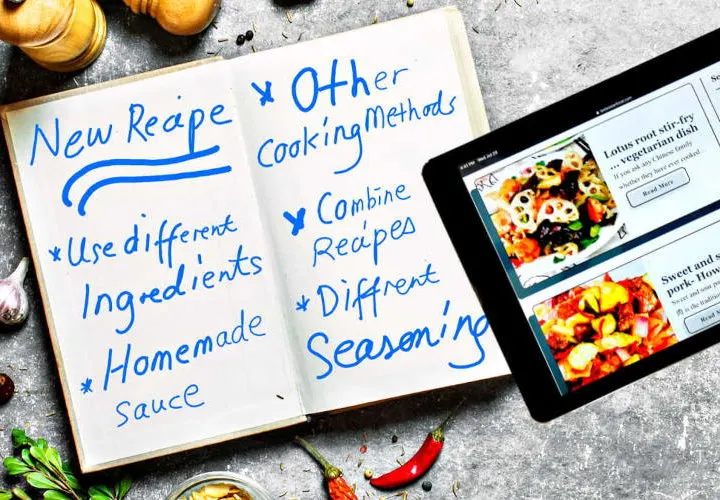
Note: This post may contain affiliate links. Please read my privacy policy for more info. I may receive commissions for purchases made through links in this post. As an Amazon Associate, I earn from qualifying purchases.
How to create a recipe
Whenever I want to cook something without a recipe, I will start by thinking around the following points.
1. Use different ingredients
My favorite way to tweak a recipe is to change the meat in a recipe and sometimes make it vegetarian by omitting it or use tofu as the source of protein.
Say if you already have a trusted kung pao chicken recipe, you can change it into a kung pao tofu. Since tofu has a softer texture and can hold more sauce, it will taste different from the original recipe. In addition, you can also steam or pan-fried instead of deep-frying the tofu, making it a unique recipe on its own.
2. Make use of the homemade pre-mixed sauce
Most Chinese stir-fry sauces are pretty easy to make and can be kept in the freezer for up to a few months without any noticeable flavor deterioration. Therefore, I pre-made some typical sauces like sweet and sour sauce, Cantonese steamed fish sauce, General Tso’s chicken sauce and kept them n small portions in the freezer.
These sauces give me ideas of how to create a recipe. If I only prepare the sauce when I cook General Tso’s chicken, chances are it will not spark off the idea to use the same sauce for other purposes., However, when I pick up the pre-made sauce from the freezer and find that there isn’t chicken available, it will trigger me to use the sauce to prepare a General Tso’s fish fillet by coating the fish fillet with flour doused in the sauce.
In short, the more pre-mix sauce I have, the more chances is there for me to mix and match with what you have in your refrigerator to cook up a new creation that I might have never thought of before.
3. Cook with another method
Steam, deep-fry, pan-fry or braise, the same ingredients will end up with different textures and flavors. So, if you always steam fish, why not try to fry it next time by coating it with your sweet and sour sauce next time? Similarly, I use to stir-fry the eggplants with garlic and minced meat. Then, one day I decided to steam the eggplant and use the garlic and meat to make a thick sauce as dressing. That simple tweak changes the taste and texture to turn it into an entirely new dish, although the using primarily the same ingredients.
4. Combine two recipes to become a new one
I love the idea to create a recipe because it is so straightforward.
I ordered some food from a local Chinese restaurant for dinner yesterday. One was tofu top with minced meat, and another was the Szechuan sweet and sour soup.
Suddenly I got the idea to combine both. The idea is to concentrate the Szechuan hot and sour soup with minced pork to become a thick gravy, then drizzle it on the block of tofu to serve. I have not done it yet, but it is already in my plan for my subsequent recipe development.
This method works well because it combines the best of both recipes into one. So, if you have two compatible recipes, give it a try to combine both into one.
5. Use a different set of seasoning to create a new recipe
An easy way to create a recipe is to use a different set of seasoning.
Debone chicken thigh with black pepper, rosemary, and thyme is my regular quick and easy dinner recipe. Sometimes I add a squeeze of lemon juice, marinate for a while, then pan-fried.
Although it is a delicious, simple meal, I want to have another taste by using a different set of seasonings to marinate the chicken.
It is pretty easy to do it. I use a new set of seasonings to marinate the chicken while using the exact method to prepare and cook it.
So I season it with an equal portion of garam masala and Chinese five-spice powder, and of course with some salt and pepper to taste.
The result is so satisfying. The best part is that the taste is distinctively different from the original recipe by only changing the seasonings.
6. Add some uncommon ingredients to an old recipe
I also like to jump out of my comfort zone to explore the possibility of adding some less common ingredients to an established recipe. After working in the restaurant for 18 years, I feel like cooking the same way as other people does not offer me satisfaction, even though I can cook better. Taste is very subjective, and what I consider the best taste might be regarded as mediocre by another person.
I also do not feel that I contribute any new input to the culinary skills by perfecting a traditional dish. On the contrary, fusion food is something that I want to explore constantly.
For example, the lemongrass chicken chop below, which I use to demonstrate how to use the tips I mentioned here, is a daring move by adding Malaysian curry powder to the established Vietnamese recipe. Sometimes things may work out fine, and some time is a failure, but that is what research and development are all about.
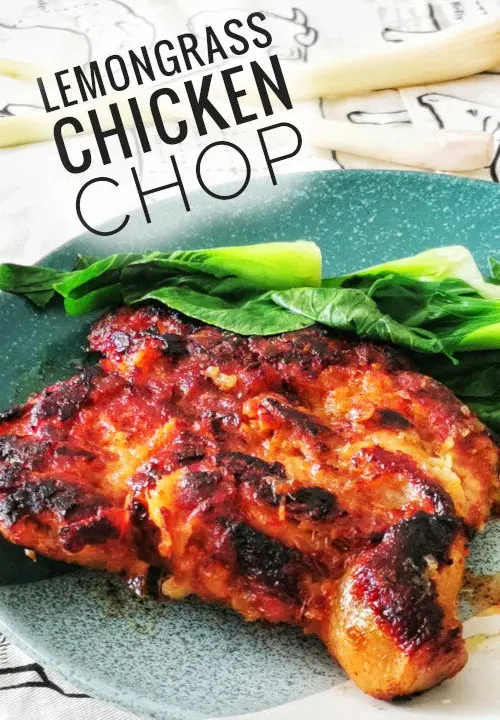
Crispy lemongrass chicken chop
This chicken shop demonstrates how I create a recipe. The recipe is based on Vietnamese-style lemongrass pork with a few modifications.
The Vietnamese-style lemongrass chicken chop is towards the sweeter side. I reduce the sugar and making some changes as below:
- Add an unusual ingredient. Since lemongrass is widely used to make curry, I am confident that curry powder should complement well with the flavor of lemongrass. However, I still want the lemongrass flavor to be distinctive. Therefore, I add a small amount of curry flavor to avoid overpowering the taste of lemongrass and fish sauce.
- Coat with a pre-mix dry coating. The original Vietnamese chicken chop is not crispy. It is served with a sauce consisting of sugar, lime juice, and fish sauce. I intend to make it different by making it crispy. With that in mind, the chicken is coated with the dry coating premix before deep frying. Therefore,
- Change the cooking method. I deep-fry the chicken with some extra oil Instead of pan-frying or grilling. This method makes the chicken chop become extra crispy, which is very different from the original recipe.
It is fun to play with food in the kitchen, although I expect my mother-in-law will frown and disapproved of what I did. However, I am pretty sure she will enjoy what I cook, as long as I keep the secret of not telling her how I tweak my recipe!
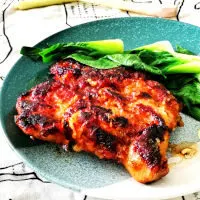
Lemongrass chicken chop
This lemongrass chicken chop is an example of using the tips I mentioned here to develop a new recipe. It is a daring move by adding Malaysian curry powder to the established Vietnamese recipe. Sometimes things may work out fine, and some time is a failure, but that is what research and development are all about.
Basically, I use the Vietnamese lemongrass as the reference by reducing the sugar, add some curry powder, coat it with flour, and deep fry. The result is totally different from the original recipe.
Ingredients
- 2 pieces of deboned chicken thighs, skin removed
- 2 tbsp ground lemongrass
- 2 tsp light soy sauce
- 2 tbsp fish sauce
- 2 tsp curry powder
- 1 tbsp sugar
- 2 tbsp honey
- 1/4 tsp ground white pepper
- 50g of the dry coating mix for frying (refer to note below)
- Vegetables oil to fry
Instructions
- Marinate the chicken for one hour with all the ingredients except the dry coating mix and oil.
- Coat the marinated chicken with the coating mix. Shake off the excess.
- Deep fry in oil for about ten minutes or until golden. Serve.
Notes
The dry coating mix consists of 50g all-purpose flour, 50g cornstarch, 1/4 tsp baking powder, and 1/2 tsp of salt. You can make more to keep for other recipes as it is used to coat most of the meat before deep-frying.
If you want to prepare only for this recipe, use half the amount as indicated above.
Recommended Products
As an Amazon Associate and member of other affiliate programs, I earn from qualifying purchases.
-
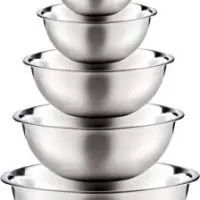 Stainless Steel Mixing Bowls by Finedine (Set of 6) Polished Mirror Finish Nesting Bowl, ¾ - 1.5-3 - 4-5 - 8 Quart - Cooking Supplies
Stainless Steel Mixing Bowls by Finedine (Set of 6) Polished Mirror Finish Nesting Bowl, ¾ - 1.5-3 - 4-5 - 8 Quart - Cooking Supplies -
 Pre-Seasshioned Cast Iron Skillet 2-Piece Set (10-Inch and 12-Inch) Oven Safe Cookware - 2 Heat-Resistant Holders - Indoor and Outdoor Use - Grill, Stovetop, Induction Safe
Pre-Seasshioned Cast Iron Skillet 2-Piece Set (10-Inch and 12-Inch) Oven Safe Cookware - 2 Heat-Resistant Holders - Indoor and Outdoor Use - Grill, Stovetop, Induction Safe -
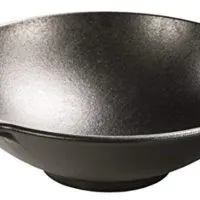 Lodge 14 Inch Cast Iron Wok. Pre-Seasoned Wok with Flattened Bottom for Asian Stir Fry and Sautees
Lodge 14 Inch Cast Iron Wok. Pre-Seasoned Wok with Flattened Bottom for Asian Stir Fry and Sautees
Nutrition Information:
Yield: 2 Serving Size: 1Amount Per Serving: Calories: 522Total Fat: 25gSaturated Fat: 5gTrans Fat: 0gUnsaturated Fat: 19gCholesterol: 83mgSodium: 2030mgCarbohydrates: 57gFiber: 5gSugar: 26gProtein: 20g
This data was provided and calculated by Nutritionix on 7/28/2021

Jim
Friday 30th of July 2021
Check your instructions for word “vomiting”. I’m sure you did not intend that.
KP Kwan
Saturday 31st of July 2021
Thank you for pointing out the hilarious mistake :) I have corrected it immediately.
KP Kwan
Friday 30th of July 2021
Hi, this is KP Kwan. I am happy to see you in this comment area, as you have read through my recipe. I am happy to reply to any questions and comments as soon as possible.